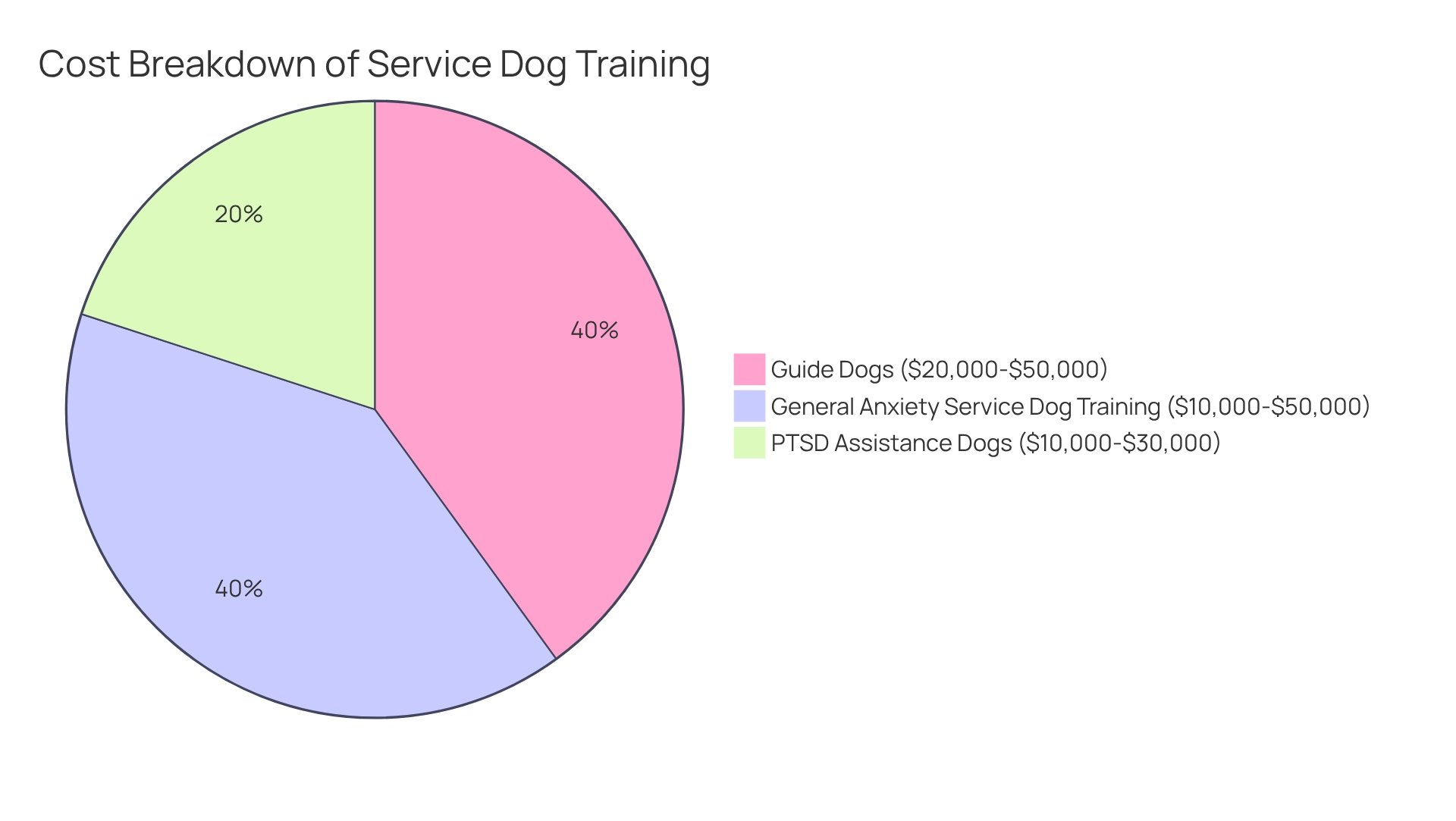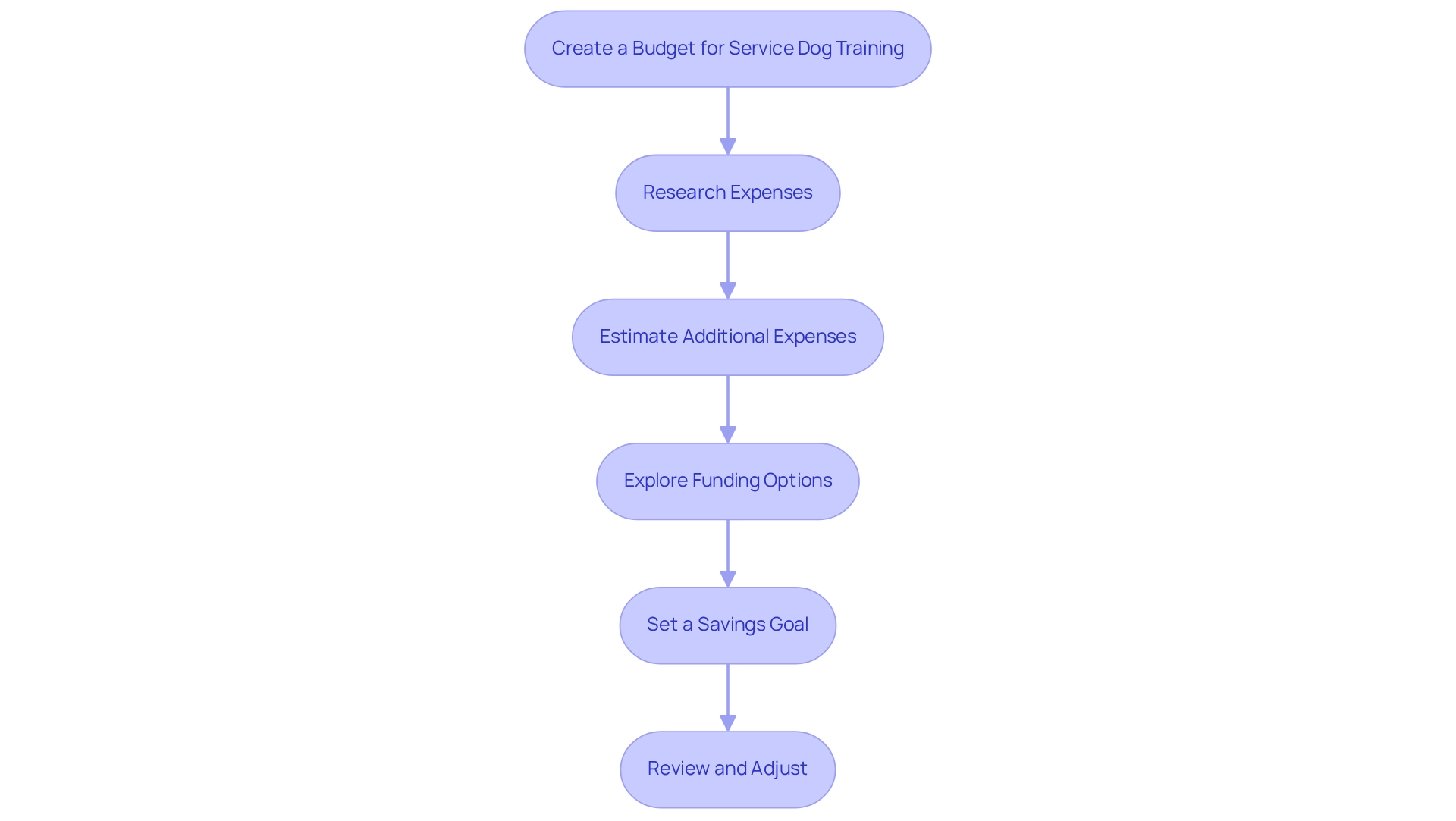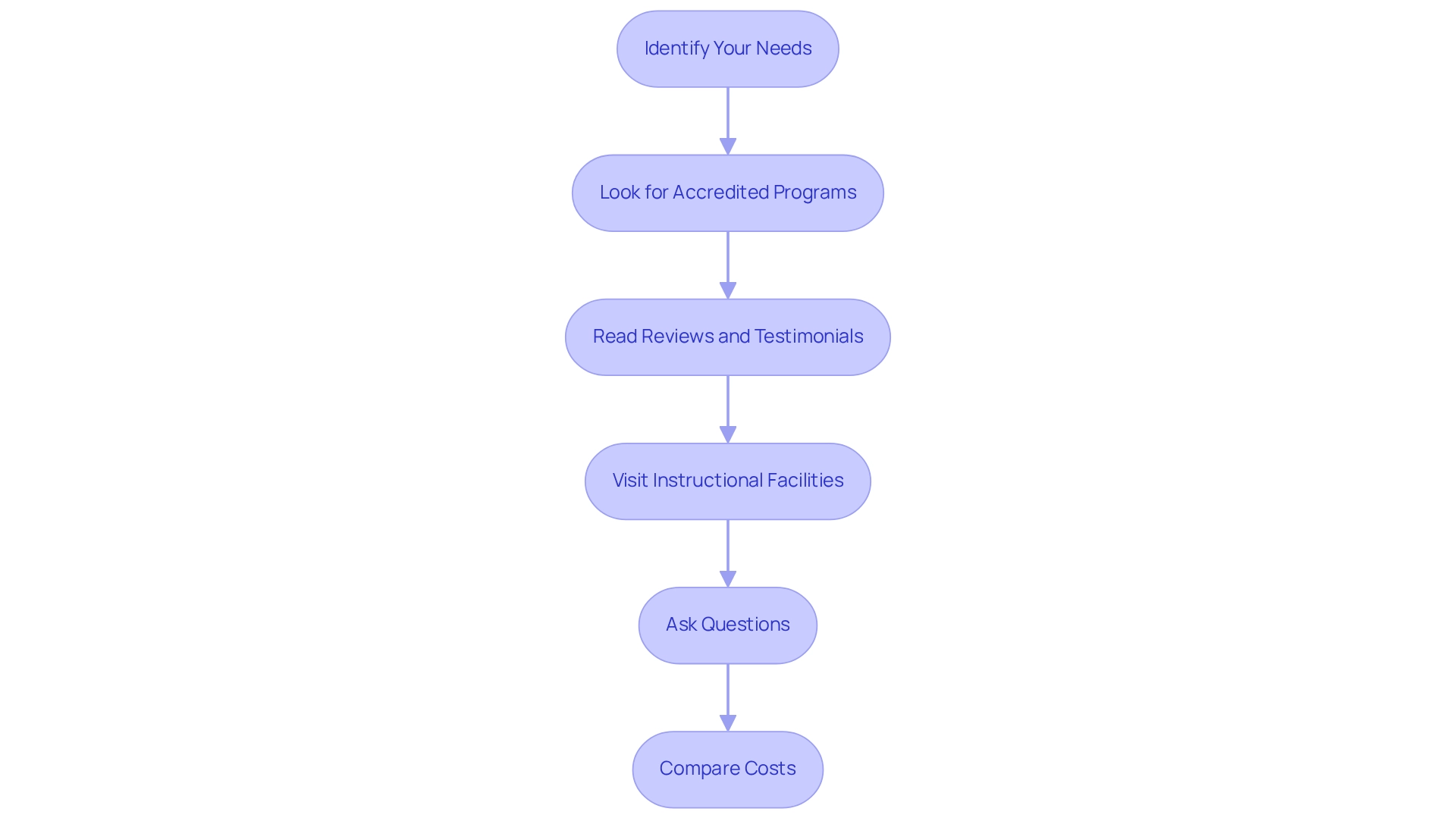

How Much Does Service Dog Training Cost for Anxiety? Key Factors Explained
by Lena Park
Last updated: May 27, 2025
Verified and Approved by:
Angela Morris,
MSW, LCSW
Fact Checked

Overview
The cost of service dog training for anxiety can be a significant concern, typically ranging from $10,000 to $50,000. This range is influenced by various factors, including:
- The type of service required
- The duration of training
- The expertise of the trainer
It’s important to recognize that this investment can feel overwhelming, especially when navigating the emotional challenges associated with anxiety. However, understanding these key factors can help prospective owners prepare for the journey ahead.
Professional training is crucial, as it ensures that the service dog can provide the necessary support. It’s also comforting to know that there may be potential financial assistance options available. This can alleviate some of the burdens associated with the costs, allowing individuals to focus more on the emotional benefits that a service dog can bring into their lives. By preparing for this significant investment, you are taking a vital step towards enhancing your well-being and finding the support you deserve.
Introduction
The journey to acquiring a service dog represents not only an emotional commitment but also a significant financial investment that can feel overwhelming. With costs ranging from $10,000 to $50,000, many prospective owners find themselves navigating a complex landscape of training expenses. These costs are influenced by various factors, including the type of service required and the expertise of trainers.
As the demand for these specialized animals continues to grow, it becomes essential to understand the intricacies of service dog training costs. This understanding is crucial for individuals seeking to enhance their quality of life with the support of a service dog.
In this article, we will explore the essential aspects of budgeting for service dog training, identify key factors that affect expenses, and examine available resources to help potential owners make informed decisions. By demystifying the financial commitment involved, we aim to empower individuals to better prepare for the rewarding journey of service dog ownership, knowing they are not alone in this process.
Understand the Basics of Service Dog Training Costs
The expenses for assistance dog education, including how much does service dog training cost for anxiety, can vary significantly based on several factors such as the specific type of support needed, the organization providing instruction, and the dog’s breed. Typically, when considering how much does service dog training cost for anxiety, it ranges from $10,000 to $50,000. For instance, guide animals usually require expenditures ranging from $20,000 to $50,000, while animals trained specifically for PTSD assistance may demand between $10,000 and $30,000; therefore, understanding how much does service dog training cost for anxiety is essential for prospective owners to assess their budget and explore financing options. Furthermore, trustworthy organizations should be transparent about their training methods and related expenses, helping individuals make informed decisions. As noted by Purina, veterinary costs during the education of assistance animals can reach thousands of dollars, adding to the overall expense.
It is also vital to recognize that assistance animals undergo extensive training through specialized programs to perform tasks directly related to their handler’s disabilities. Although there is no legal requirement for assistance animals to be certified, obtaining certification from recognized organizations can provide credibility and reassurance that the animal has met specific skill standards.
Common misunderstandings regarding assistance animal education expenses often lead to unrealistic expectations. For example, some believe that all training costs are uniform or that self-directed learning is a significantly cheaper option. However, expert insights reveal that professional training is crucial for ensuring the effectiveness of assistance animals, particularly for conditions such as anxiety and ADHD.
In 2025, the typical costs for assistance animal training for anxiety remain stable compared to previous years, reflecting the ongoing need for these specialized companions. Community fundraising initiatives frequently support individuals in need of assistance animals, highlighting the financial challenges many face in acquiring these vital partners. By dispelling these misconceptions and providing a realistic overview of how much does service dog training cost for anxiety, prospective owners can better prepare for the financial commitment involved in obtaining a support dog. Moreover, assistance dog owners enjoy full public access rights under the Americans with Disabilities Act (ADA), allowing them to bring their assistance dogs into public spaces and receive housing accommodations, which adds significant value to their investment.

Identify Key Factors Affecting Training Expenses
Several essential elements significantly influence the cost of assistance dog training:
- The type of service required plays a crucial role in determining expenses. Whether the service dog is intended for mobility assistance, psychiatric support, or other specific needs, the complexity of training can vary greatly.
- The duration of the program is a key factor; basic training might last only a few months, while specialized instruction could extend beyond a year, leading to higher costs.
- Geographic location also impacts training expenses, as local demand and living standards can differ. For example, urban areas often have higher prices compared to rural settings.
- The expertise of the trainer is another consideration. Highly skilled trainers may charge premium rates, yet their experience often results in better-trained assistance animals, validating the investment.
- Lastly, the choice between private sessions and group classes affects pricing, with private sessions typically being more expensive but offering tailored guidance that can be beneficial for specific skill needs.
Assistance animals undergo rigorous training through specialized programs and professional instructors to perform tasks directly related to their handler’s disability. This can include guiding individuals with visual impairments, alerting those who are hearing-impaired to sounds, or providing support for individuals dealing with anxiety or ADHD. While there is no legal requirement for assistance animals to be certified, obtaining certification from reputable organizations can lend credibility and assurance that the animal meets specific proficiency standards. A longitudinal study involving 51 recipients of assistance dogs from the Hearing Dogs for Deaf People organization revealed the positive impact of service dogs on mental health, showcasing significant reductions in anxiety and depression. This underscores the importance of investing in quality training, as the benefits extend beyond mere companionship to enhancing overall well-being.
Furthermore, credible organizations should maintain transparency regarding their training methods and associated costs, ensuring that prospective clients fully understand their investment. Flexible payment options for training can start as low as $32.25, which raises the question of how much does service dog training cost for anxiety, making these vital services more accessible for those in need, especially considering the various factors influencing educational expenses.
Create a Budget for Service Dog Training
Establishing a budget for assistance dog education involves several essential steps to ensure you are financially prepared for this important commitment.
- Research Expenses: Start by gathering information on the typical costs for training in your area, as these can vary significantly based on the specific services needed. When considering how much does service dog training cost for anxiety, it is important to recognize that educating a support dog can be a substantial investment, often totaling thousands of dollars, with expenses differing greatly depending on the type of training and support required.
- Estimate Additional Expenses: In addition to training, think about ongoing costs such as food, veterinary care, equipment, and insurance. Yearly expenses for an assistance dog can range from $500 to $2,000, influenced by the dog’s needs and your location. It’s vital to recognize that 47% of pet parents have faced pet-related debt, and 42% struggle to cover unexpected veterinary bills, which can average between $800 and $1,500. This highlights the importance of a thorough financial overview when considering how much does service dog training cost for anxiety.
- Explore Funding Options: Look into grants, scholarships, and financial assistance programs provided by various organizations. Many nonprofits and government entities offer support that can significantly ease the financial burden of acquiring a support dog. Some organizations may even provide service dogs at no cost or a reduced fee, making it more attainable for those in need.
- Set a Savings Goal: Determine how much you need to save each month to reach your budget target before starting the preparation process. This proactive approach can empower you to manage your finances effectively.
- Review and Adjust: Regularly evaluate your budget and make adjustments as necessary based on changes in your financial situation or training needs. Flexibility is crucial, especially considering the long wait times—ranging from 1 to 5 years—for assistance dogs due to high demand and limited availability. This underscores the significance of careful financial planning and adaptability.
By following these steps, you can create a comprehensive budget that prepares you for the financial responsibilities of dog ownership, ensuring you are ready to provide the necessary support for your new companion. As noted by Service Dog Certifications, training a dog for the full range of support functions a person may require can take up to two years, making advance planning essential.

Research Training Programs and Resources
When researching training programs for service dogs, it’s essential to consider a few thoughtful steps to ensure you make an informed decision that truly meets your needs:
- Identify Your Needs: Start by clearly defining the specific tasks you require your service dog to perform, tailored to your unique disability. This clarity will significantly assist your search for an appropriate development program.
- Look for Accredited Programs: Seek out organizations accredited by reputable bodies, such as Assistance Dogs International. This accreditation ensures adherence to high educational standards recognized by healthcare professionals, providing peace of mind.
- Read Reviews and Testimonials: Take the time to investigate online evaluations and testimonials from previous clients. This will help you assess the effectiveness and reputation of the program, allowing you to make a more informed choice.
- Visit Instructional Facilities: If possible, visit instructional facilities to observe classes in action and meet the instructors. This firsthand experience can provide valuable insight into the educational environment.
- Ask Questions: Engage with program representatives about their teaching methods, the qualifications of their instructors, and the support offered post-instruction. This dialogue is crucial to ensure comprehensive care for you and your future service dog.
- Compare Costs: Examine the expenses related to various programs, taking into account what is encompassed in the price, such as follow-up assistance and extra instructional sessions. Understanding the financial obligation is essential, especially when considering how much does service dog training cost for anxiety, as it can involve considerable costs.
Research indicates that pet ownership can significantly enhance mental health, with nearly 47% of individuals believing that having a pet improves their well-being. This underscores the importance of choosing the right assistance dog development program to maximize these benefits. As Daniele Giansanti poignantly remarked, “It’s challenging to be an assistance animal, just like it’s frequently difficult to be disabled … Please always honor assistance animals and the individuals who require them.” By selecting a recognized program, you can ensure that your assistance dog receives the training necessary to support your mental well-being effectively. Additionally, as healthcare professionals increasingly acknowledge the value of service dogs in treatment plans, being well-informed about training options can empower you to advocate for your needs with confidence.

Conclusion
The journey to obtaining a service dog represents a profound financial and emotional commitment, with training costs that can vary significantly, ranging from $10,000 to $50,000 based on multiple factors. It’s crucial for prospective owners to grasp these costs, as this understanding fosters informed budgeting and financial planning. Elements such as the type of service required, training duration, location, and the expertise of the trainer all contribute significantly to the overall expense. Acknowledging the importance of professional training can help dispel common misconceptions, emphasizing the value of investing in high-quality training programs.
Creating a comprehensive budget is essential in preparing for the responsibilities that come with service dog ownership. This preparation includes not only the initial training costs but also the ongoing expenses such as food, veterinary care, and necessary equipment. Exploring available funding options and establishing savings goals can help ease some of the financial burdens, making this journey more manageable. Regularly reviewing and adjusting the budget ensures that prospective owners remain ready for any changes in their financial circumstances or training needs.
Ultimately, investing in a service dog can profoundly enhance one’s quality of life, offering invaluable support tailored to individual needs. By thoroughly researching training programs and understanding the associated costs, individuals can approach this rewarding journey with confidence. Empowering oneself with knowledge about the financial commitment involved will pave the way for a successful partnership with a service dog, enriching the lives of both the handler and the dog.
Frequently Asked Questions
How much does service dog training cost for anxiety?
The cost of service dog training for anxiety typically ranges from $10,000 to $50,000, depending on various factors such as the type of support needed and the organization providing the training.
What are the costs associated with training different types of assistance animals?
Guide animals usually require expenditures ranging from $20,000 to $50,000, while animals trained specifically for PTSD assistance may demand between $10,000 and $30,000.
Why is it important to understand the costs of service dog training?
Understanding the costs is essential for prospective owners to assess their budget and explore financing options for obtaining a service dog.
Are there additional expenses related to assistance dog education?
Yes, veterinary costs during the education of assistance animals can reach thousands of dollars, contributing to the overall expense.
Is certification necessary for assistance animals?
While there is no legal requirement for assistance animals to be certified, obtaining certification from recognized organizations can provide credibility and reassurance regarding the animal’s training.
What common misconceptions exist about assistance animal education expenses?
Many people believe that all training costs are uniform or that self-directed learning is a significantly cheaper option. However, professional training is crucial for the effectiveness of assistance animals.
How do community fundraising initiatives support individuals needing assistance animals?
Community fundraising initiatives often help individuals cover the financial challenges associated with acquiring assistance animals.
What rights do assistance dog owners have under the Americans with Disabilities Act (ADA)?
Assistance dog owners enjoy full public access rights under the ADA, allowing them to bring their assistance dogs into public spaces and receive housing accommodations.
Certify Your Emotional Support Animal Today

Why You Can Rely on Us?
At Wellness Wag, we believe your pet deserves care rooted in both science and compassion. Each article is carefully researched, written in clear language for pet owners, and then reviewed by qualified professionals to ensure the information is evidence-based, current, and practical for real-life care. Our goal is to help you feel confident in making informed decisions about your pet’s health and well-being.
Reviewed by
Angela Morris, MSW, LCSW
Angela is a licensed clinical social worker with 20 years of experience in patient advocacy and community mental health. She has assisted numerous clients with ESA evaluations and brings a deep understanding of disability accommodations, ensuring that all information is accurate, supportive, and practical.

Written by :
Lena Park
Last Updated :
May 27, 2025












